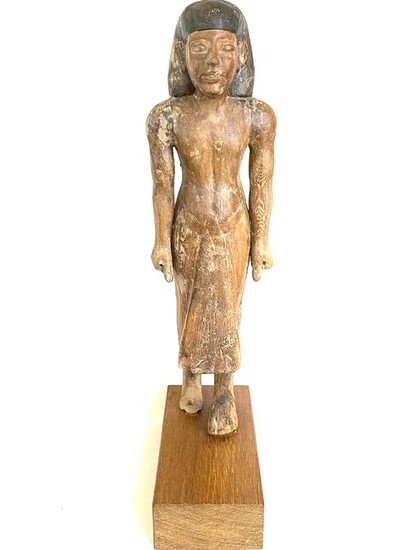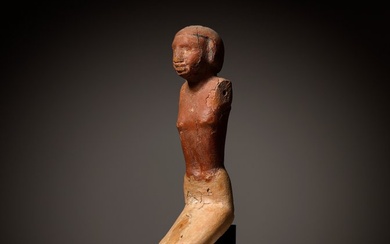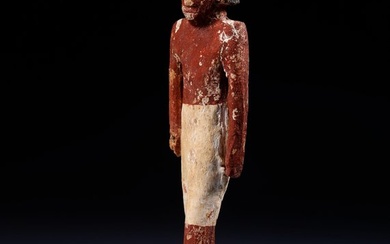Ancient Egyptian Wood Funerary Figure of a Standing Man - 67 cm Tall *without base
The XXVIth Egyptian dynasty covers the period from -664 bc to -525 bc, known as the Saite period, after the name of the city of Sais, from which the dynasty originated. Taking advantage of the troubles of the Assyrians, one of the governors, Psammetic I (-663 / -609) , succeeded in expelling them thanks to Lydian and Greek mercenaries. Psammetic I reunifies the country. His reign and those of his successors are marked by the "saite renaissance": they will imitate the Middle Kingdom and even the Old Kingdom. Cultural Renaissance during the Saite period (-664 / -525) , state art, which had taken over under the Kushites, develops thanks to the restoration of order and economic prosperity. The notables of the ancient pyramid texts reappear on the sarcophagi, and the shift of the center of power from Saïs to Memphis makes the Memphis classicism of the Old Kingdom the artistic model more than ever imitated to affirm the restored greatness. The monumental activity is strong in Memphis, where the Serapeum of Saqqara is enlarged, while culminates the cult of the bull Apis, in the general movement of devotion to the sacred animals, receptacles of the divine power incarnated on earth, substitutes of a royalty subject to so many jolts, to guarantee the progress of the universe. There are also many constructions inside the delta, especially at Sais, the cradle of the dynasty, where the great temple of the goddess Neith becomes one of the main centers of religious and cultural life, especially known for its medical school. It is near the house of life of the temple of Neith, that in the middle of the fifth century BC. BC, Herodotus seeks to penetrate the knowledge of the scribes. It was also during the saite period that many large corpora of religious and funerary texts were codified (Saite recension of the Book of the Dead developed in the New Kingdom) . This is an exceptional an unique FUNERARY WOODEN FIGURE. According to Catawiki's archeology expert, Peter Reynaers, "if you look at the high waste, the sagging belly, the broad belt like fold under the belly in his loincloth, the legs one next to the other one, it seems to me a piece late new kingdom or the 26th dynasty being Saite renaissance. . . . . indeed the nose is in-keeping with Amarna or post Amarna style. . . . . That is my take on the sylistic features. If it is New Kingdom, it is a very very rare statue indeed and most notroiously because it is then a rare remnant of private sculpture of the Amarna or post-Amarna period. (Achnaton, Tut-Anch-Amun, Horemheb & Ay were the pharaohs in that period) . " Provenance: According to previous owners, Mr. Hettelinck most likely bought the wooden figure in London, possibly from one of the big auction houses between 60 and early 70s, and brought it into the Netherlands. Thence by decent to his son, afterwards the figure remained in the private collection of the family until August, 2018; The wooden figure was bought from the previous owner by Dr. H. Ruf, Florida, USA. Dr. H. Ruf, became the first to own this piece after a long stay of it in the hands of one single person and his son. The Seller can prove that the lot was obtained legally , provenance statement seen by Catawiki. Important information. The seller guarantees that he is entitled to ship this lot. The seller will take care that any necessary permits will be arranged. The seller will inform the buyer about this if this takes more than a few days.
[ translate ]View it on
Sale price
Estimate
Time, Location
Auction House
The XXVIth Egyptian dynasty covers the period from -664 bc to -525 bc, known as the Saite period, after the name of the city of Sais, from which the dynasty originated. Taking advantage of the troubles of the Assyrians, one of the governors, Psammetic I (-663 / -609) , succeeded in expelling them thanks to Lydian and Greek mercenaries. Psammetic I reunifies the country. His reign and those of his successors are marked by the "saite renaissance": they will imitate the Middle Kingdom and even the Old Kingdom. Cultural Renaissance during the Saite period (-664 / -525) , state art, which had taken over under the Kushites, develops thanks to the restoration of order and economic prosperity. The notables of the ancient pyramid texts reappear on the sarcophagi, and the shift of the center of power from Saïs to Memphis makes the Memphis classicism of the Old Kingdom the artistic model more than ever imitated to affirm the restored greatness. The monumental activity is strong in Memphis, where the Serapeum of Saqqara is enlarged, while culminates the cult of the bull Apis, in the general movement of devotion to the sacred animals, receptacles of the divine power incarnated on earth, substitutes of a royalty subject to so many jolts, to guarantee the progress of the universe. There are also many constructions inside the delta, especially at Sais, the cradle of the dynasty, where the great temple of the goddess Neith becomes one of the main centers of religious and cultural life, especially known for its medical school. It is near the house of life of the temple of Neith, that in the middle of the fifth century BC. BC, Herodotus seeks to penetrate the knowledge of the scribes. It was also during the saite period that many large corpora of religious and funerary texts were codified (Saite recension of the Book of the Dead developed in the New Kingdom) . This is an exceptional an unique FUNERARY WOODEN FIGURE. According to Catawiki's archeology expert, Peter Reynaers, "if you look at the high waste, the sagging belly, the broad belt like fold under the belly in his loincloth, the legs one next to the other one, it seems to me a piece late new kingdom or the 26th dynasty being Saite renaissance. . . . . indeed the nose is in-keeping with Amarna or post Amarna style. . . . . That is my take on the sylistic features. If it is New Kingdom, it is a very very rare statue indeed and most notroiously because it is then a rare remnant of private sculpture of the Amarna or post-Amarna period. (Achnaton, Tut-Anch-Amun, Horemheb & Ay were the pharaohs in that period) . " Provenance: According to previous owners, Mr. Hettelinck most likely bought the wooden figure in London, possibly from one of the big auction houses between 60 and early 70s, and brought it into the Netherlands. Thence by decent to his son, afterwards the figure remained in the private collection of the family until August, 2018; The wooden figure was bought from the previous owner by Dr. H. Ruf, Florida, USA. Dr. H. Ruf, became the first to own this piece after a long stay of it in the hands of one single person and his son. The Seller can prove that the lot was obtained legally , provenance statement seen by Catawiki. Important information. The seller guarantees that he is entitled to ship this lot. The seller will take care that any necessary permits will be arranged. The seller will inform the buyer about this if this takes more than a few days.
[ translate ]




